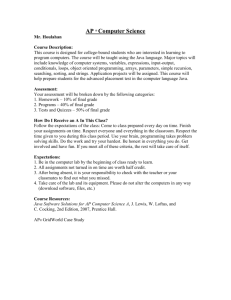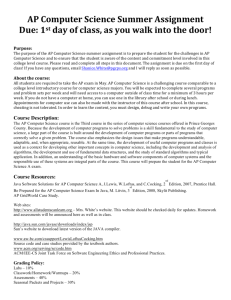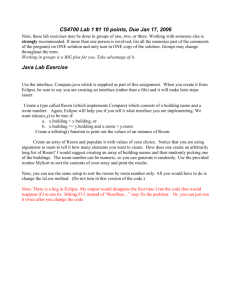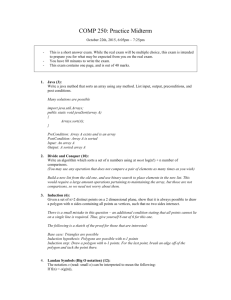Objects for Organizing Data -- Introduction
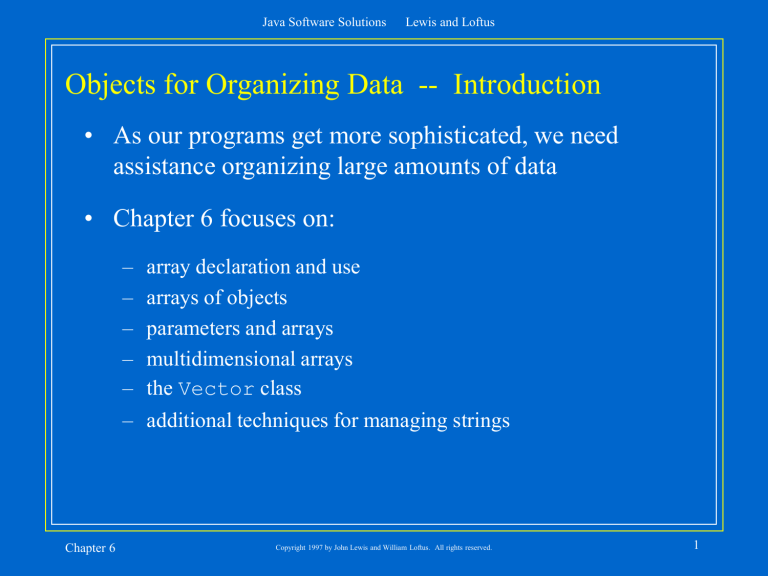
Java Software Solutions Lewis and Loftus
Objects for Organizing Data -- Introduction
• As our programs get more sophisticated, we need assistance organizing large amounts of data
• Chapter 6 focuses on:
– array declaration and use
– arrays of objects
– parameters and arrays
– multidimensional arrays
– the Vector class
– additional techniques for managing strings
Chapter 6 Copyright 1997 by John Lewis and William Loftus. All rights reserved.
1
Java Software Solutions Lewis and Loftus
Arrays
• An array is an ordered list of values
• Each value has a numeric index
• An array of size N is indexed from zero to N-1
• The following array of integers has a size of 10 and is indexed from 0 to 9
0 1 2 3 4 5 6 7 8 9 scores
79 87 94 82 67 98 87 81 74 91
Chapter 6 Copyright 1997 by John Lewis and William Loftus. All rights reserved.
2
Java Software Solutions Lewis and Loftus
Arrays
• A particular value in an array is referenced using the array name followed by the index in brackets
• For example, the expression scores[4] refers to the value 67 (which is the 5th value in the array)
• That expression represents a place to store a single integer, can can be used wherever an integer variable can
• For example, it can be assigned a value, printed, used in a calculation
3
Chapter 6 Copyright 1997 by John Lewis and William Loftus. All rights reserved.
Java Software Solutions Lewis and Loftus
Arrays
• An array stores multiple values of the same type
• That type can be primitive types or objects
• Therefore, we can create an array of integers, or an array of characters, or an array of String objects, etc.
• In Java, the array itself is an object
• Therefore the name of the array is a object reference variable, and the array itself is instantiated separately
4
Chapter 6 Copyright 1997 by John Lewis and William Loftus. All rights reserved.
Java Software Solutions Lewis and Loftus
Declaring Arrays
• The scores array could be declared as follows: int[] scores = new int[10];
• Note that the type of the array does not specify its size, but each object of that type has a specific size
• The type of the variable scores is int[] (an array of integers)
• It is set to a newly instantiated array of 10 integers
• See Basic_Array.java
5
Chapter 6 Copyright 1997 by John Lewis and William Loftus. All rights reserved.
Java Software Solutions Lewis and Loftus
Declaring Arrays
• Some examples of array declarations: float[] prices = new float[500]; boolean[] flags; flags = new boolean[20]; char[] codes = new char[1750];
Chapter 6 Copyright 1997 by John Lewis and William Loftus. All rights reserved.
6
Java Software Solutions Lewis and Loftus
Bounds Checking
• Once an array is created, it has a fixed size
• An index used in an array reference must specify a valid element
• That is, they must be in bounds (0 to N-1)
• The Java interpreter will throw an exception if an array index is out of bounds
• This is called automatic bounds checking
• Its common to inadvertently introduce off-by-one errors when using arrays
7
Chapter 6 Copyright 1997 by John Lewis and William Loftus. All rights reserved.
Java Software Solutions Lewis and Loftus
Bounds Checking
• Each array object has a public constant called length that stores the size of the array
• It is referenced through the array name (just like any other object): scores.length
• Note that length holds the number of elements, not the largest index
• See Reverse_Numbers.java
and
Adjust_Test_Scores.java
8
Chapter 6 Copyright 1997 by John Lewis and William Loftus. All rights reserved.
Java Software Solutions Lewis and Loftus
Array Declarations Revisited
• The brackets of the array type can be associated with the element type or with the name of the array
• Therefore float[] prices; and float prices[]; are essentially equivalent
• The first format is usually more readable
9
Chapter 6 Copyright 1997 by John Lewis and William Loftus. All rights reserved.
Java Software Solutions Lewis and Loftus
Initializer Lists
• An initializer list can be used to instantiate and initialize an array in one step
• The values are delimited by braces and separated by commas
• Examples: int[] units = {147, 323, 89, 933, 540,
269, 97, 114, 298, 476}; char[] letter_grades = {'A', 'B', 'C',
'D', 'F'};
10
Chapter 6 Copyright 1997 by John Lewis and William Loftus. All rights reserved.
Java Software Solutions Lewis and Loftus
Initializer Lists
• Note that when an initializer list is used:
– the new operator is not used
– no size value is specified
• The size of the array is determined by the number of items in the initializer list
• An initializer list can only be used in the declaration of an array
• See Primes.java
and Sales_Analysis.java
Chapter 6 Copyright 1997 by John Lewis and William Loftus. All rights reserved.
11
Java Software Solutions Lewis and Loftus
Arrays of Objects
• The elements of an array can be object references
• The declaration
String[] words = new String[25]; reserves space to store 25 references to String objects
• It does NOT create the String objects themselves
• Each object stored in an array must be instantiated separately
Chapter 6 Copyright 1997 by John Lewis and William Loftus. All rights reserved.
12
Java Software Solutions Lewis and Loftus
Arrays of Objects
• See Children.java
and Presidents.java
• Objects can have arrays as instance variables
• Therefore, fairly complex structures can be created simply with arrays and objects
• The software designer must carefully determine an organization of data and objects that makes sense for the situation
• See Roll_Call.java
13
Chapter 6 Copyright 1997 by John Lewis and William Loftus. All rights reserved.
Java Software Solutions Lewis and Loftus
Arrays as Parameters
• An entire array can be passed to a method as a parameter
• Like any other object, the reference to the array is passed, making the formal and actual parameters aliases of each other
• Changing an array element in the method changes the original
• An array element can be passed to a method as well, and follow the parameter passing rules of that element's type
• See Array_Test.java
14
Chapter 6 Copyright 1997 by John Lewis and William Loftus. All rights reserved.
Java Software Solutions Lewis and Loftus
Multidimensional Arrays
• A one-dimensional array stores a simple list of values
• A two-dimensional array can be thought of as a table of values, with rows and columns
• A two-dimensional array element is referenced using two index values
• To be precise, a two-dimensional array in Java is an array of arrays, therefore each row can have a different length
15
Chapter 6 Copyright 1997 by John Lewis and William Loftus. All rights reserved.
Java Software Solutions Lewis and Loftus
Multidimensional Arrays
• An initializer list can be used to create and set up a multidimensional array
• Each element in the list is itself an initializer list
• Note that each array dimension has its own length constant
• See Multi_Array_Test.java
and
Soda_Survey.java
Chapter 6 Copyright 1997 by John Lewis and William Loftus. All rights reserved.
16
Java Software Solutions Lewis and Loftus
The Vector Class
• An object of class Vector is similar to an array in that it stores multiple values
• However, a vector
– only stores objects
– does not have the indexing syntax that arrays have
• Service methods are used to interact with a vector
• The Vector class is part of the java.util package
• See Beatles.java
and ZZ_Top.java
17
Chapter 6 Copyright 1997 by John Lewis and William Loftus. All rights reserved.
Java Software Solutions Lewis and Loftus
The Vector Class
• An important difference between an array and a vector is that a vector can be thought of as a dynamic, able to change its size as needed
• Each vector initially has a certain amount of memory space reserved for storing elements
• If an element is added that doesn't fit in the existing space, more room is automatically acquired
18
Chapter 6 Copyright 1997 by John Lewis and William Loftus. All rights reserved.
Java Software Solutions Lewis and Loftus
The Vector Class
• A vector is implemented using an array
• Whenever new space is required, a new, larger array is created, and the values are copied from the original to the new array
• To insert an element, existing elements are first copied, one by one, to another position in the array
• Therefore, the implementation of Vector in the API is not very efficient
19
Chapter 6 Copyright 1997 by John Lewis and William Loftus. All rights reserved.
Java Software Solutions Lewis and Loftus
The StringTokenizer Class Revisited
• We've seen a StringTokenizer object separate a string into separate tokens
• By default, those tokens are delimited by white space
• But by using other StringTokenizer constructors, we can define the delimiters used to define a token
• We can also set whether we want the delimiters themselves returned as tokens
• See Voltaire.java
and URL_Tokens.java
Chapter 6
20
Copyright 1997 by John Lewis and William Loftus. All rights reserved.
Java Software Solutions Lewis and Loftus
The StringBuffer Class
• Recall that the value of a String object is immutable; once set it cannot be changed
• The StringBuffer class can be used to define a character string whose value can change
• It's service methods include the ability to append and insert characters
• See Money.java
• However, most functionality defined by the
StringBuffer class can be accomplished with
String objects and string concatenation
21
Chapter 6 Copyright 1997 by John Lewis and William Loftus. All rights reserved.

